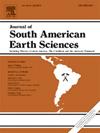Leguminosae fossil woods from the Miocene Palo Pintado Formation, Salta: evidence of environmental changes
IF 1.5
4区 地球科学
Q3 GEOSCIENCES, MULTIDISCIPLINARY
引用次数: 0
Abstract
The presence of Piptadenioxylon, Suguio and Mussa, a Leguminosae wood is reported in the Palo Pintado Formation of late Miocene age. This unit is part of the Payogastilla Group, which outcrops in the Valle Calchaquí, Salta Province. The anatomical characteristics of the wood allow it to be assigned to P. chimeloi. It has been documented for the El Palmar Formation (Entre Ríos Province, Argentina) and in the Pleistocene deposits of Río Tiete (Brazil). This finding is particularly important as it is the second record of woods for this formation, which also hosts Ranunculodendron anzoteguiae. This allowed for evolutionary, paleoclimatic, and paleoecological considerations, as well as the analysis of the distribution of this taxon to its current botanical affinity related to Piptadenia, present in Mexico and Argentina. Other poorly preserved woods from the same fossiliferous site were also analyzed, allowing for some considerations on taphonomy.
萨尔塔中新世Palo Pintado组的豆科植物化石:环境变化的证据
在晚中新世的Palo Pintado组中发现了Piptadenioxylon、Suguio和一种豆科木Mussa。该单位是Payogastilla集团的一部分,该集团在萨尔塔省Calchaquí山谷露头。木材的解剖特征允许它被分配到P. chimeloi。在El Palmar组(Entre Ríos省,阿根廷)和Río Tiete(巴西)更新世沉积物中都有记录。这一发现尤其重要,因为这是该地层的第二次森林记录,该地层还拥有毛茛属植物。这就考虑了进化、古气候和古生态方面的考虑,并分析了该分类群的分布,以确定其与墨西哥和阿根廷的Piptadenia有亲缘关系。我们还分析了来自同一化石遗址的其他保存较差的木材,考虑到地层学上的一些考虑。
本文章由计算机程序翻译,如有差异,请以英文原文为准。
求助全文
约1分钟内获得全文
求助全文
来源期刊

Journal of South American Earth Sciences
地学-地球科学综合
CiteScore
3.70
自引率
22.20%
发文量
364
审稿时长
6-12 weeks
期刊介绍:
Papers must have a regional appeal and should present work of more than local significance. Research papers dealing with the regional geology of South American cratons and mobile belts, within the following research fields:
-Economic geology, metallogenesis and hydrocarbon genesis and reservoirs.
-Geophysics, geochemistry, volcanology, igneous and metamorphic petrology.
-Tectonics, neo- and seismotectonics and geodynamic modeling.
-Geomorphology, geological hazards, environmental geology, climate change in America and Antarctica, and soil research.
-Stratigraphy, sedimentology, structure and basin evolution.
-Paleontology, paleoecology, paleoclimatology and Quaternary geology.
New developments in already established regional projects and new initiatives dealing with the geology of the continent will be summarized and presented on a regular basis. Short notes, discussions, book reviews and conference and workshop reports will also be included when relevant.
 求助内容:
求助内容: 应助结果提醒方式:
应助结果提醒方式:


